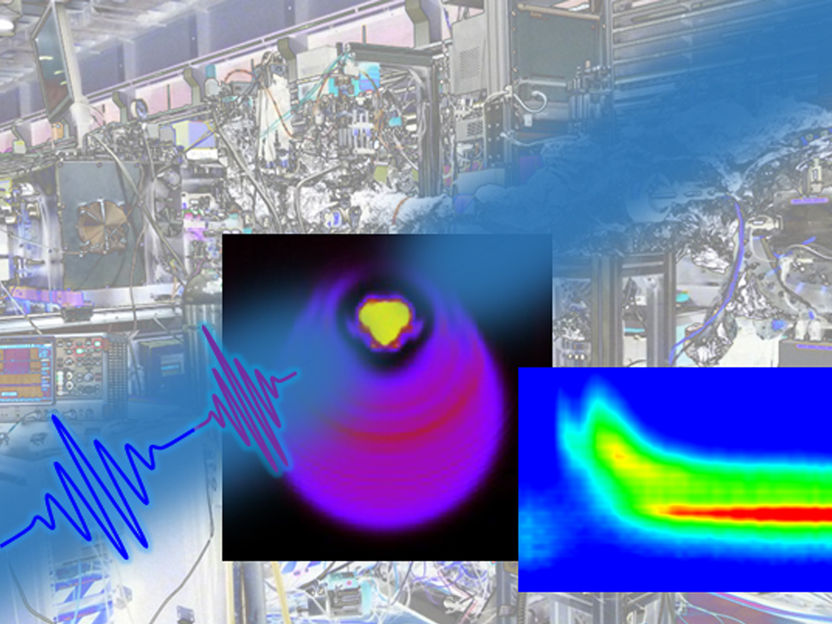Nanobubbles in nanodroplets
Researchers investigate ultrafast reaction of superfluid helium triggerd by extreme ultraviolet laser pulses
A team headed by Professor Frank Stienkemeier at Freiburg’s Institute of Physics and Dr. Marcel Mudrich, professor at the University of Aarhus in Denmark, has observed the ultrafast reaction of nanodroplets of helium after excitation with extreme ultraviolet radiation (XUV) using a free-electron laser in real time.

Excitation of helium nanodroplets by ultra-short laser pulses.
AG Stienkemeier
Lasers generating high-intensity and ultra-short XUV and X-ray pulses give researchers new options for investigating the fundamental properties of matter in great detail. In many such experiments, material samples in the nanometer range are of particular interest. Some scientists use helium droplets no larger than a few nanometers as a means of transporting and studying embedded molecules and molecular nanostructures. Helium droplets are ideally suited for this purpose because they possess extraordinary properties. At an extremely low temperature of only 0.37 degrees above absolute zero, they move frictionlessly and are thus considered superfluids. Moreover, helium droplets usually are inert to the embedded molecules’ chemical processes and are completely transparent to infrared and visible light.
The team led by Stienkemeier and Mudrich wanted to find out how one of these superfluid droplets itself reacts when hit directly by an intense XUV laser pulse. The researchers used the world's first and only seeded free-electron laser FERMI in Trieste, Italy, which delivers high-intensity XUV pulses at a wavelength set by the team. Supported by model calculations, the researchers identified three elementary reaction steps: A very fast localization of electrons, the population of metastable states, and the formation of a bubble that eventually bursts at the surface of the droplets and ejects a single excited helium atom.
“For the first time, we have managed to directly follow these processes in superfluid helium, which take place in an extremely short time,” says Mudrich. “The results help to understand how nanoparticles interact with energetic radiation and then decay,” Stienkemeier adds. “This is essential information for the work aiming at directly imaging individual nanoparticles," he explains, “as it is being carried out at new intense radiation sources such as the European X-ray laser XFEL in Hamburg.”
Original publication
Other news from the department science
These products might interest you

NANOPHOX CS by Sympatec
Particle size analysis in the nano range: Analyzing high concentrations with ease
Reliable results without time-consuming sample preparation

Eclipse by Wyatt Technology
FFF-MALS system for separation and characterization of macromolecules and nanoparticles
The latest and most innovative FFF system designed for highest usability, robustness and data quality

DynaPro Plate Reader III by Wyatt Technology
Screening of biopharmaceuticals and proteins with high-throughput dynamic light scattering (DLS)
Efficiently characterize your sample quality and stability from lead discovery to quality control

Get the chemical industry in your inbox
By submitting this form you agree that LUMITOS AG will send you the newsletter(s) selected above by email. Your data will not be passed on to third parties. Your data will be stored and processed in accordance with our data protection regulations. LUMITOS may contact you by email for the purpose of advertising or market and opinion surveys. You can revoke your consent at any time without giving reasons to LUMITOS AG, Ernst-Augustin-Str. 2, 12489 Berlin, Germany or by e-mail at revoke@lumitos.com with effect for the future. In addition, each email contains a link to unsubscribe from the corresponding newsletter.


























































